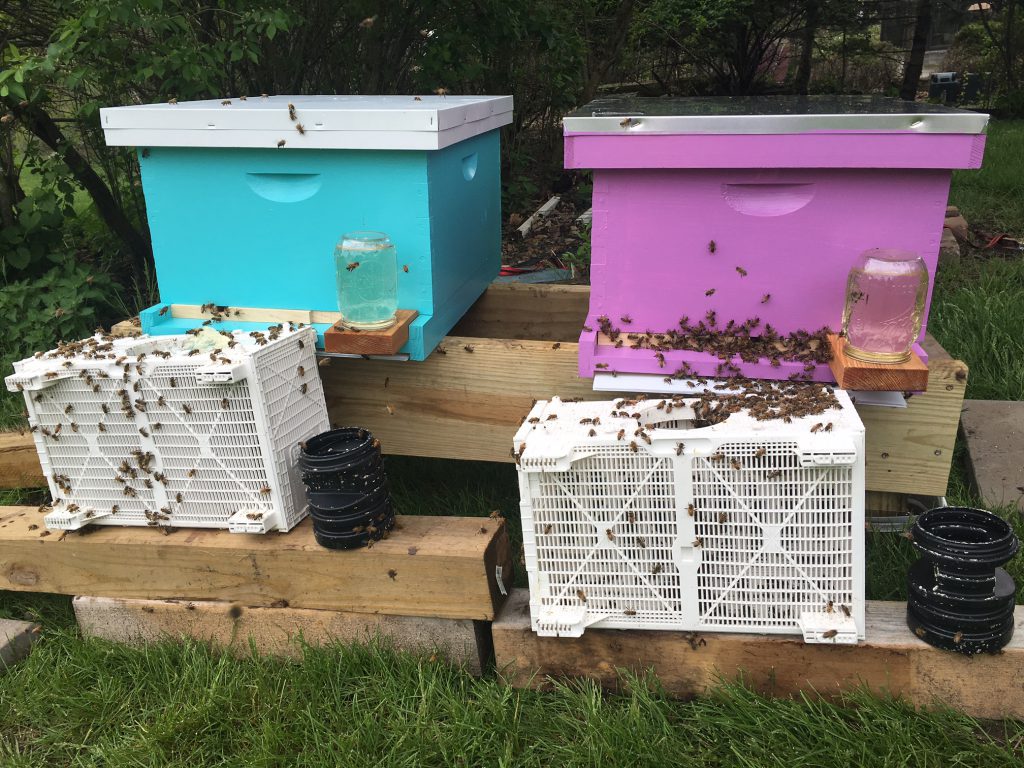
Everything was going well. The weather was getting warmer, my bees were collecting pollen and raising brood. It was early April and I was doing a hive inspection. Everything looked great! My bees survived the winter and were starting their second year off by building up the hive. The population wasn’t as large as it had been the previous summer, but that happens over the winter. Some colonies are a little slower to build up than others. I closed up the hive, took notes in my beekeeper log noting that everything looked good, and went on with life for another week.
The following week I had noticed there wasn’t as much activity around the hive as there normally was. One or two bees would fly off here and there, and I noticed several dead bees being tossed out of the hive. So I opened the lid. Ants. Giant black ants were all over the inner cover. Hundreds of them. In a panic, I tossed all of the ants on the inner cover out into the grass and started going frame by frame through the hive to eliminate as many as I could see. I brought a new box and bottom board out and transferred every single frame into a new hive. I contacted several other local beekeepers after I couldn’t find a way to keep the ants from trying to get back into the hive. I tried every single thing I could find online to repel ants or kill them without harming the bees…and my last resort was building a new hive stand out of whatever scrap wood I could find that had buckets of water around each leg so the ants would drown before they could reach the hive. So that worked.
The damage from the ants was pretty terrible. They had gotten to the honey, to the brood and eggs. There was a lot of dead brood, and eggs were tossed out of the comb onto the bottom of the hive. Hoping they would be able to recover, I closed up the new hive and kept an eye on things every day that week. And then Mother Nature stepped in. The temperature dropped drastically over the next few days and the small colony was not big enough to stay warm. More bees were dying. By the end of that week I looked into the hive and saw a handful of bees left. I couldn’t let them die though. How unfair that they had survived the whole winter, only to be wiped out by ants and some bad weather in April?!
I found the box that the colony had originally arrived in last Summer and put every single living bee I could find back into that box, and luckily the queen was still among them. I brought them into my house and put them in my laundry room for the night so I could figure out what I could possibly do next. And then I realized I couldn’t do anything. That was my only colony and I had no other bees to add to the hive to help keep them warm, I had no frames of brood to help them grow in numbers…so I contacted one of the beekeepers I met who lives nearby. He said he could take the queen and her remaining bees and start a new colony. So the following day, I drove the Ant Queen and her workers to Naperville and they were dropped into a new hive with more bees and eggs.
Two whole days went by between that day and the day I could pick up the new packages of bees that I had ordered in January. Those were two of the most depressing days as a beekeeper for me. Everything was gone.
I learned a few important lessons from those ants. Number one, I learned how to prevent them from getting into the hives. Number two, I learned how to kill them fast without using any chemicals (boiling hot water and dish soap dumped right over their little ant heads) and number three, I learned that I need more than one hive going at a time in case something like this happens again. So now I have three. It’s a little more work but it’s already paid off BIG TIME since I started up again May 1. I’ve had one hive kill their queen and make their own new one, I’ve had to kill one of the queens myself because it was only laying drone eggs and not workers (and I had to spend $42 to buy a new queen when they wouldn’t raise their own from new eggs). But right now, at this very moment, all three hives are doing well. They’re building up their numbers and bringing in pollen and nectar to make honey. And they’re all on a hive stand that has buckets of water around each leg to keep an ant invasion from ever happening again.

Leave a Reply